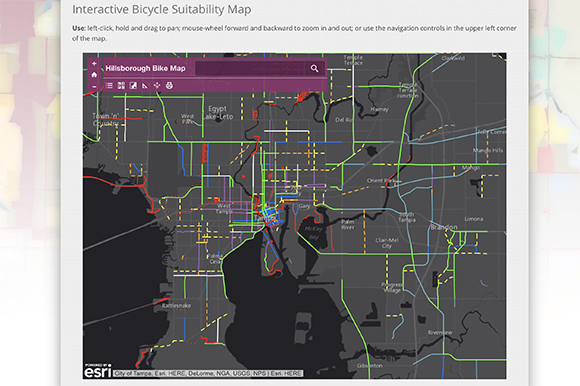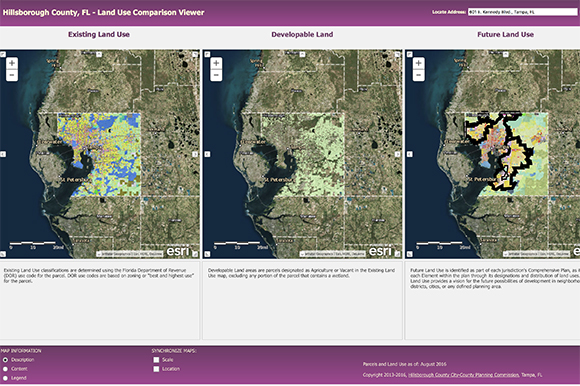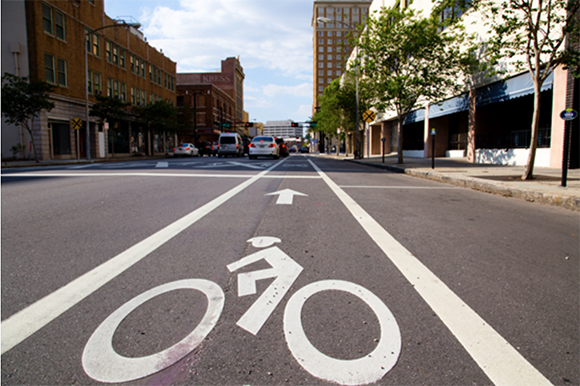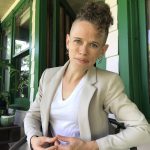Vision Zero focuses on making local streets safer for bicyclists, pedestrians
Whether you’re driving a truck or car, riding a bicycle or walking across the street, you can help prevent deaths and injuries by being more alert to the other guys. Ditto for government. Vision Zero arms urban planners with tools to make streets safer for everyone.
‘Zero’ is the number on the tip of every tongue at the Hillsborough Metropolitan Planning Organization as the MPO shifts into gear for its biggest project of the fiscal year: launching the Vision Zero campaign.
The idea that “one traffic death is too many” is the cornerstone of Vision Zero, a revolutionary grassroots movement that originated in the streets of Sweden in 1994, and has more recently emerged in U.S. cities, including Boston, New York, D.C., San Francisco, Seattle and now Tampa as a multi-tiered effort to eliminate bicyclist and pedestrian fatalities on urban roadways.
In introducing the first of four Vision Zero workshops this fall, Hillsborough County is adopting a ‘zero tolerance’ attitude toward traffic fatalities, and joins the Ft. Lauderdale area as only the second region in Florida to enact Vision Zero.
Why here? Why now?
Over the past five years, Hillsborough County has averaged 167 traffic deaths per year. To put that in perspective, Hillsborough averages 33 more traffic fatalities, annually, than other counties with comparable populations nationwide — and the odds are worse for non-motorists traveling on Hillsborough roads. In January, the Tampa Bay Times reported that 51 deaths in 2015 made for a record-breaking year of pedestrian fatalities in Hillsborough County.
Tampa City Councilwoman and MPO Policy Committee Chair Lisa Montelione spoke candidly in the first Vision Zero workshop at Ragan Community Park, noting the impact of loss in her community.
“I drive Busch Boulevard almost every day. You see those emergency curtains up and you know there’s someone lying there, dead. Whether you see it in person or in the newspaper or on TV — those individuals are people’s children, their sisters, their mothers, their dads, their brothers. It’s heartbreaking,” Montelione says.
Richard Retting has more than 30 years of experience in traffic engineering, safety, and research. The former Deputy Assistant Commissioner for Traffic Safety with the New York City Department of Transportation (DOT), now a consultant with Sam Schwartz Engineering, opened the workshop with an overview of Vision Zero. He emphasizes that traffic violence is a public health crisis.
Retting cites a NHTSA study indicating that on average, one pedestrian dies in a crash-related accident every two hours in the United States.
“If we averaged two deaths an hour on airplanes, we would recognize that as an absolute crisis. Pedestrian safety is no different,” Retting says.
In the first Vision Zero workshop, county officials, law enforcement officers, safety advocates, urban developers, traffic engineers and local citizens gathered for a series of roundtable discussions to identify problems and conceptualize solutions for Hillsborough County roadways.
Taking action, making a difference
The workshop focused on four areas of impact, called ‘Action Tracks’, that guide the Vision Zero campaign. The four Vision Zero Action Tracks are:
- One Message, Many Voices: Focus on finding effective ways to deliver the Vision Zero message to the community and to strengthen collaborative efforts between the MPO, law enforcement agencies, roadway engineers and citizens to achieve the goal of zero pedestrian deaths in Hillsborough County. This group began outlining plans to identify outreach partners, broaden the Vision Zero coalition to include more citizens, and deliver the message to a greater audience.
- The Future Will Not Be Like the Past: Facilitate cultural change to promote design standards that reflect best practices and foster a better relationship between traffic investments and community outcomes. This group advised clearly defined rules and incentives for developers, a commitment to researching and developing strategic investments, and designing ‘natural fit’ solutions for safer Hillsborough County roadways.
- Paint Saves Lives: Encourage creative efforts to deliver high impact, low cost treatments at high benefit areas. This group looked toward a data-driven approach to identifying high-volume crash areas and treating them with ‘pop-up’ solutions. The group’s goals are to allocate resources that will disrupt poor learned behaviors, create physical safety barriers, and increase pedestrian visibility at a minimal cost–for example: brightly painted bike lanes.
- Consistent and Fair: Identify how to promote rules and good behavior with a ‘no excuses’ approach to eliminating unsafe driving habits. This group, which included representatives from local law enforcement, explored solutions to promote good behavior. This includes stepping up DUI law enforcement, improving community perception of red light cameras, and working with schools to ensure kids are getting to school safety through parent outreach and education.
Actions deliver results
The Hillsborough County Vision Zero campaign is rooted in similar principles to the efforts of Vision Zero NYC, one of the earliest Vision Zero adopters in the U.S. — and a robust, data-backed example of the program’s efficacy.
Vision Zero diverges from traditional traffic safety programs in its assertion that traffic deaths are 100 percent preventable, because cities and counties “get what they build for.” The campaign operates on the belief that death and injury on the streets is caused not by ‘accidents’ in traffic, but rather by poor roadway designs combined with unsafe learned behaviors practiced by motorists, bicyclists and pedestrians. Vision Zero campaigns assert that those deadly designs and behaviors can–and must–be modified to eliminate traffic fatalities and injuries.
Vision Zero takes a multilateral approach to improving roadways and human behavior by driving political commitment, promoting data-driven solutions and systems-based programs, fostering community engagement and transparency, and establishing pedestrian safety as an issue of social equity and public health.
Vision Zero launched in 2014 in New York City, where the NYC DOT improved the design of more than 50 intersections by including more pedestrian spaces, clarifying lane markings, reducing crossing distances and installing new protected bicycle paths. The DOT also re-timed signals, reduced speeds along large roads from 30 mph to 25 mph, and installed more than 400 speed bumps in residential neighborhoods throughout the city. Furthermore, the city cracked down on DUIs and traffic law enforcement, increasing summonses for speeding by 42 percent and failure-to-yield summonses by 125 percent. Vision Zero NYC also hosted more than 50 citywide public events and delivered street safety education programs in 620 schools in 2014.
The outcome? The first year of Vision Zero in New York City was the safest for pedestrians in the city’s history (since record-keeping began in 1910), with a 23 percent decrease in pedestrian fatalities from 2013. Today, Vision Zero NYC continues to work with confidence toward its goal of zero pedestrian fatalities.
Inspired by the successes in New York City, the first Vision Zero workshop in Hillsborough County served primarily as a brainstorming session, culminating in the series of group presentations in which each ‘Action Track’ presented their findings and ideas. Next, comes action.
In three successive workshops that will take place over the next year, Vision Zero Hillsborough will move forward in outlining budgets and drafting action plans for safer streets. The next Vision Zero coalition meeting will take place Jan 31, 2017, location TBA.
In the meantime, you can get involved with the campaign for safer streets, and report traffic concerns in your neighborhood. Simply scroll down the Hillsborough MPO Vision Zero webpage to find an interactive map where you can pinpoint concerns and offer suggestions, and make your voice heard.

















